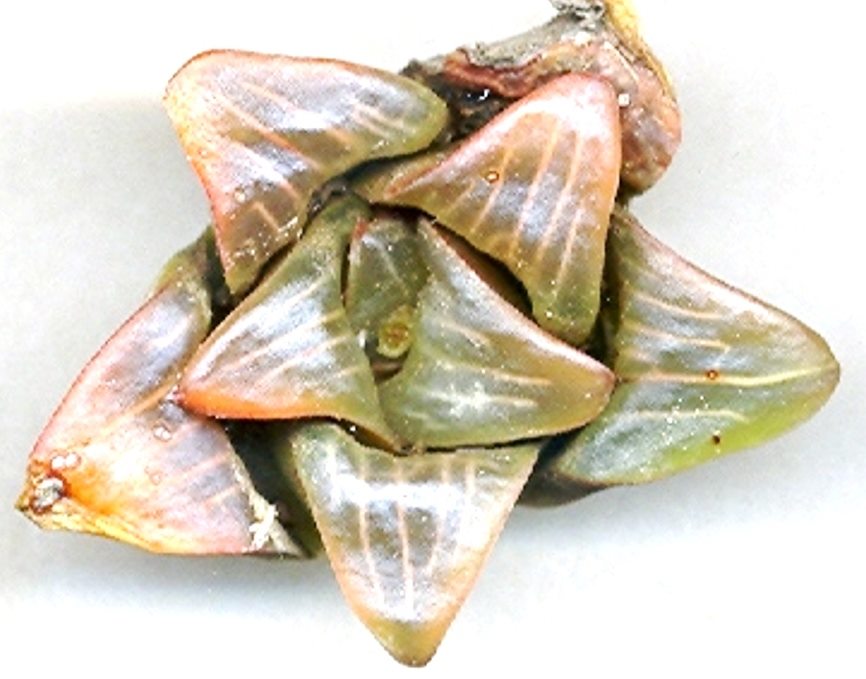70. 2019.8.2, MBB7500 – This is a really interesting population. Mid-south of area 1 of my map and east of mutica MBB7941 by a few kilometers. It is a “hybrid” population mirabiisXmutica flowering March. It has the name H. hammeri and this itself raises a very interesting phenomenon. Who “discovered” it, who actually collected it and how did material get to a foreign national to describe as a new species? Why is of course something else. Nature Conservation permit regulations are painfully restrictive and heading to where it may become illegal to be in possession of a “species” like this limited to this one locality. Is this another case of the binomial system prostituted for collector interest? A question for the collector (and probably the author of the name too) … “Just what is H. hammeri?”
Some of these look to take on a floribunda like twist and slightly elongated leaf … It seems to be very probable that floribunda is completely integrated into the greater retusa group (species) and this is what I have pointed out in many posts. Floribunda appears in real form a short way east of this – again in a retusoid mirabilid habitat and alone.
These are more pictures from Die Kop. H. ha..ha..mmeri. Flowering time might be a mirabiloid dominant.
The inevitable that I was trying to avoid looms. Stephen Gould wrote his book “Rocks of Ages” providing his view of “non-overlapping magisteria” for science and religion. A very warped one as I wrote in Updates. Science claims dominion over knowledge and dismisses metaphysics as lunacy. Religions claim dominion over spirituality and condemns mysticism as satanic. Both views are plainly nonsensical. Some while ago I posted on metaphysics and indirectly on how the outer world is an illusion of space and time. Reduction and particularization of science leads us out and away from truth. The fact is it is a conscious creation. Knowledge and truth is the same thing and must exist everywhere at once? Species on the physical plane have no reality because all matter is a projection and an illusion. There is humongous literature on all this. I am not telling you this as something new and my discovery. Science, having captured the designation for a process of acquiring knowledge, is suppressive and deliberately dumbs us down to the unreality of physical creation and the truths about it. Matter is created from 5 subtle elements described by countless mystics as earth, water, fire, air and ether. They say, that associated with these are even more subtle elements of sound, taste, touch, and smell. These are energy states (string theory?) and they are represented diagrammatically in the physical form by the 5 platonic solids (they are not solids – they depict energy fields with differing vibratory states). This earth = cube, water = icosahedron, fire = tetrahedron, air = hexagon and ether = dodecahedron. Chaurasi is described as the wheel of 84. 8,400 000 life forms and each life form is a particular combination of the five elements. Plants have only the element of water, invertebrates have fire/air, fire/water, fire/earth, fish are fire/water, reptiles are fire and earth, birds are fire, air and water, mammals and marsupials are fire, air, earth and water. Man alone has all five. All this used to be common knowledge and in Plato’s time, knowledge of the dodecahedron was made secret and divulged to people on the penalty of death! I am no weirdo – I am just telling you how it is.
71. 2019.8.4, MBB7937 – This is a really wonderful locality for mutica that Jakub Jilemicky pointed me to. Some distance E Die Kop and could be the SE limit before mutica is subsumed again in mirabiloids. The quartz is very ferruginous?
That Jakub discovered it is simply indicative of the nature of exploration and “discovery” when there is so much ground to be covered. I will touch on this again.
The group picture of Kobus Venter with Daphne and I was taken here.
72. 2019.8.5, MBB7535 – A little north of the last and on a sparsely quartzy shale substrate. The red leaf colors are probably due to soil factors unknown and I have never grown many muticas. It was a species fairly unknown to me even if one of the first I saw when I was at Karoo Garden. In cultivation I very much doubt you could get such rich color – reds especially seem to be reaction to direct sun in all the retusoids especially. I posted that toothy one before and in the “groenewaldii” series a green many leaved plant similarly toothed. Just another issue of what species descriptions where like with G G Smith when single plants were used.
That DK graph makes a point but is also very weak. What we actually have is a two bar graph of confidence and knowledge against time. It is with such a graph that we make assumptions about each others confidence (arrogance) and ignorance (knowledge). The Dunning-Kruger Effect just suggests that there is a tendency in all of us to be more confident in relation to our actual knowledge than we should be. Do we see ourselves as either unassuming and knowledgeable and others as arrogant and ignorant? Is this while we struggle to balance all that against a guess at what it means to be a nice person? I would have to apologize for how I am seen, for the assumptions made as to how I see others, while perhaps others may need to apologize for how they see me and so on and so forth. All this futile wasted effort when we should be objectively trying to seek the truth. Something I do not know is just how all these mutica variants behave in cultivation. I do know I had a mutica and a pygmaea in cultivation that looked identical except for bract colour.






































